
Facelift UK
Welcome to Dr Nizar Hamadeh Clinic, where we specialize in exceptional facelift procedures tailored to enhance your natural beauty. Our team and dedicated professionals are committed to providing you with the highest standard of care and achieving outstanding results.
Everything You Need to Know
As the years pass, the skin becomes less firm and elastic, and wrinkles and fine lines appear. While some people choose to let nature take its course, others may decide to undergo a facelift to achieve a more defined jaw line and look younger again.
There can be a stigma around getting cosmetic surgery. It’s essential to remember that surgery is a personal decision. People might choose a facelift to appear younger and more refreshed. They might also want to address signs of ageing that make them feel self-conscious.
What is a Facelift?
A facelift, also known as rhytidectomy, is a transformative procedure that can help reverse the signs of ageing. It’s designed to address signs of ageing in the face and neck, including skin laxity and loss of facial tissue, particularly in the lower face. As we age, factors such as gravity, sun exposure, and the natural loss of skin elasticity can lead to sagging skin, deepening wrinkles, and a tired appearance. Our facelift procedures can help restore a more youthful and rejuvenated appearance, making you look as young as you feel on the inside.
We understand that each individual has unique concerns and goals. Dr N Hamadeh, educated in London, will work with you to develop a personalised treatment plan that addresses your specific needs. Whether you need a full facelift to address many areas of the face or a deep plane facelift for targeted improvements, we have the expertise to deliver exceptional results with the best hands in the UK through a thorough consultation.
How does a Facelift work?
The surgeon performs a facelift under general anesthesia, also known as general anesthesia. It takes between 2 and 4 hours to complete. The surgical technique will depend on what area is being lifted, but it typically involves making incisions in the hairline, around the ears, and on the lower lip. The surgeon often lifts the jawline and neck simultaneously. The surgeon separates the skin from the underlying fat and facial muscles, using general anesthesia to ensure the patient is comfortable and pain-free throughout the procedure. Then, someone trims or rearranges it. The skin is then re-draped over the face’s new contours, removing any excess skin. The surgeon closes the incisions with stitches and wraps the face in bandages.
The purpose of a facelift is to enhance the appearance of the face. Some other cosmetic surgeries are not designed to do this. It does this by targeting particular areas. The surgeon will select the incisions and skin removal based on your individual needs and goals.
What are the types of Facelifts?
There are several different facelifts, each achieving distinct results. The traditional facelift is a common type. It is best for those with moderate to severe wrinkles and involves an incision in the hairline, around the ears, and in the lower lip.
Mini facelifts are a less invasive option often used to treat wrinkles around the eyes and mouth. A mid-facelift focuses on the area between the eyes and upper cheeks, while a lower facelift, including a SMAS facelift, is more focused on the lower half of the face, including jowls.
An endoscopic facelift also uses small incisions and special instruments to minimise scarring. A threadlift uses threads to lift and support the skin.
What is minimal access cranial suspension?
Minimal Access Cranial Suspension (MACS) is a type of facelift surgery. It uses small incisions and minimal dissection to reduce wrinkles and sagging skin. This procedure is performed on patients of all ages and skin types, and MACS is used to treat the face, neck, and jowls
Difference between Facelift and Necklift?
A facelift is a surgical procedure performed to improve the appearance of the face, while a neck lift enhances the appearance of the neck. A neck lift can be performed alone or with a facelift.
How common are Facelifts?
According to the USA-based American Society of Plastic Surgeons, facelifts are becoming increasingly popular. In 2020, around 234274 facelifts were performed in the US. Most patients who undergo a facelift are between the ages of 40 and 60, although the procedure is suitable for people of any age.
What Facelift surgery can’t do?
Facelift surgery cannot stop the natural aging process, and results may vary depending on your anatomy and skin type. The procedure can also be expensive, so it’s essential to weigh the pros and cons before deciding.
Reasons for having a Facelift
The most common reason for having a facelift is to improve the appearance of the face. Other reasons for having the procedure include:
- To correct facial asymmetry
- To improve drooping skin around the eyes
- To reduce wrinkles and lines
- To tighten loose skin
- To improve self-esteem and confidence
At what age can I get a Facelift?
There is no one “right age” when getting cosmetic surgery, such as a facelift; however, most patientswho undergo a facelift range between the ages of 40 and 60, with a particular indication for youngerpatients with relatively early signs of aging. If you are considering a facelift and are not in this agerange, speak with an experienced plastic surgeon about the potential risks and benefits, especially ifyou have concerns about your general health.
There is no one “best” age for a facelift, as the decision to undergo the procedure is personal and depends on your individual goals.
What type of Facelift would suit me?
There is no one “best” type of facelift, as each procedure is designed to achieve different results. For example, if you are looking for a less invasive option, mini facelift surgery may be the best choice, as it involves tightening the underlying muscle and tissue for a more natural and longer-lasting result. However, if you are looking for more dramatic results and maximum results by targeting the underlying tissue, a traditional facelift may be better.
What Should I Expect from a Facelift Consultation?
During your facelift consultation, Dr. Hamadeh will assess your individual goals and objectives and perform a physical examination.
If you have a history of keloid scarring or active acne, a Facelift may not be suitable for you. Certain medical conditions, like diabetes or high blood pressure, can also cause complications. If you are considering a facelift, be sure to speak with your doctor. Discuss your medical history and any concerns you may have, as they may recommend further surgery to address any potential complications in the soft tissues and blood supply.
They will also discuss the different types of facelifts and which one may be the best option for you. It’s important to ask questions and get all the information you need before deciding.
How physically fit do I have to be to have a facelift?
You do not have to be very physically fit to have a facelift, but you should be in generally good health. During your consultation, Dr. Hamadeh will give you specific instructions on preparing for your surgery.
How to Prepare for a Facelift
There are a few things you can do to prepare for a facelift, such as:
- Schedule a consultation with Dr Hamahdeh
- Get a complete physical examination.
- Stop smoking at least six weeks before the procedure.
- Avoid sun exposure and tanning beds for at least four weeks before the surgery.
- Eat a healthy diet and drink plenty of water.
- Arrange for someone to drive you home after the surgery.
Potential Risks and Side Effects of Facelifts?
All surgeries come with risks, and there are potential risks and side effects associated with facelifts include bleeding, infection, nerve damage, and scars from scarring.However, these risks are usually minimal and can be minimised by choosing an experienced and qualified consutant.
People choose not to have a facelift because of the surgery’s potential risks and side effects. Other reasons can include the cost of the procedure and the recovery time required.
Before And After
Tips that help ensure a smooth recovery process after surgery?
Some post-operative care tips that will help ensure a smooth recovery process after surgery include:
- Follow your surgeon's instructions carefully.
- Avoid strenuous activity for the first few weeks.
- Take it easy and avoid bending or lifting heavy objects.
- Drink plenty of water and eat a healthy diet.
- Avoid smoking and alcohol.
After having a facelift, following these things is essential to ensure that you heal correctly and avoid any complications. To learn more about the Recovery from Facelifts it’s worth reading our latest article, it has lots of information on how to recover quickly without increasing risks of complications.
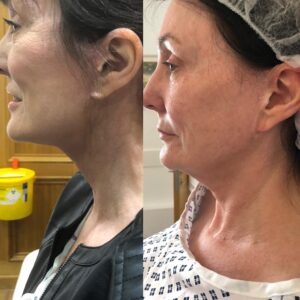

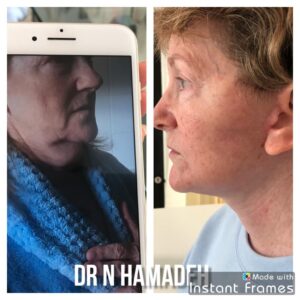
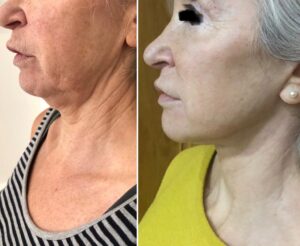
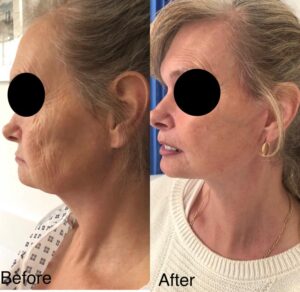

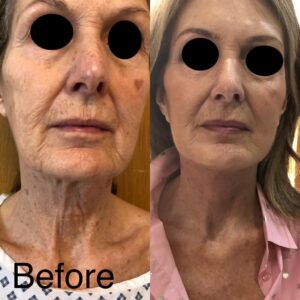

What to expect during Facelift recovery?
After your facelift surgery, which is a kind of surgery, you can expect some swelling and bruising, which usually resolve within a few weeks. Dr. Hamadeh recommends wearing a compression garment for the first few days to help reduce the swelling. Patients require a minimum of two weeks off from work to recover.
It is essential to avoid strenuous activities, excessive sun exposure, and alcohol consumption during this period. After about a week, you should be able to resume normal activities.
Non-Surgical Facelift?
Botox
Botox is a popular non-surgical option for improving the appearance of the face. In Botox, the doctor injects a small amount of botulinum toxin into the muscles of the face to relax them. This helps reduce the appearance of wrinkles, fine lines, and crow’s feet. The effects of Botox typically last between three and six months.
Dermal Fillers
Dermal fillers are another popular non-surgical option for improving the appearance of the face. They are injections of a substance that helps plump up the skin and reduce the appearance of wrinkles and lines. Dermal fillers last for six to twelve months.
Botox and dermal fillers are good options for people who do not want or cannot have surgery. They are invasive and require no downtime. However, you may need to repeat them every few months to maintain the desired results
Botox and dermal fillers are good options for people who do not want or cannot have surgery. They are invasive and require no downtime. But, you may need to repeat them every few months to maintain the desired results.
Facelift with Necklift?
A neck lift is a cosmetic surgery procedure used to improve the appearance of the neck by reducing wrinkles and tightening loose skin. The procedure can be done on both men and women and typically takes between 1 and 2 hours to complete. Many choose to get a neck lift done simultaneously with a facelift because the two procedures often go hand-in-hand, but it is important to discuss potential complications and risks with your plastic surgeon before making a decision.
How long do the results of Facelift surgery last?
The facelift results are usually long-lasting, but they may not be permanent. We discuss the details of different Facelifts & how long they last in this article. The effects of aging and gravity will eventually take their toll, and you may need to have another facelift down the road to maintain your final result.However, there are also non-surgical treatments that can help support the results of facelift surgery and keep your face looking young and fresh. These treatments can be used in addition to surgery or as an alternative for those who do not want to undergo surgical treatments. A skilled surgeon and proper technique are also essential factors in the longevity of facelift results, along with maintaining a good diet and exercise routine.
What Surgeries can be Performed in Conjunction with a Facelift?
Several surgeries can perform a facelift, targeting different areas including the layer of the face, brow lift, eyelid surgery, and laser skin resurfacing. Consult with a specialist to explore available options, including laser resurfacing. Discover what will yield the best results, including enhancements to the upper face. In some cases, the surgeon can also perform a facelift on the eyelids to improve their appearance.
Blepharoplasty is the term used for this. This involves removing excess skin and fat from the eyelids. It’s performed as a standalone procedure or in conjunction with an initial meeting with a consultant to discuss your expectations and potential procedures such as a brow lift, cheek implants, chin implants, or liposuction. Sometimes, having many procedures done at once can be beneficial. This can help achieve the patient’s desired results. You can also combine a facelift with a brow lift to enhance the upper face.
You can also combine neck liposuction with them. This combination gives the patient a more youthful appearance.
Facelifts can be an excellent way to combat the signs of ageing and help you look and feel your best. It’s a good idea to consult with a plastic surgeon to see if you are a good candidate for surgery. You can also discuss your expectations.
With the help of an experienced and qualified surgeon, you can achieve natural-looking results that can endure for many years. You can feel confident and happy with your appearance.
Frequently Asked Questions.
A facelift is like any surgery. It carries risks such as infection, bleeding, scarring, and adverse reactions to anesthesia. Yet, you can reduce these risks by choosing a skilled, experienced doctor and following post-operative instructions.
Yes, there are non-surgical alternatives such as injectables (like Botox and dermal fillers) and skintightening treatments (like laser or radiofrequency). However, these options may provide temporary results and are typically best suited for milder signs of aging.
Not everyone who wants surgery actually needs it — and that’s perfectly okay.
A good candidate is someone who’s in good overall health, has realistic expectations, and wants to improve facial balance rather than chase perfection.
During your consultation, Dr. Hamadeh will evaluate your facial structure, skin type, and medical history, but he’ll also listen to what truly bothers you. His goal isn’t just to change how you look — it’s to help you feel more confident and natural in your own skin.
Most facial plastic procedures offer long-lasting results, but not all changes are permanent — and that’s completely normal.
Factors like age, genetics, and lifestyle play a big role in how your results hold up over time.
Dr. Hamadeh’s approach focuses on natural techniques that age gracefully with you. Instead of creating results that feel “frozen” or artificial, his surgeries enhance your features in a way that remains balanced and elegant for years to come.
Experience is everything.
Facial surgery is one of the most delicate fields in medicine — every millimeter matters. A surgeon’s eye for symmetry, technical precision, and understanding of facial anatomy can make all the difference between a good result and a truly natural one.
Dr. Nizar Hamadeh brings years of experience in both functional and cosmetic facial surgery. His patients often describe their experience as reassuring and collaborative, knowing they’re in hands that prioritize both safety and artistry.
Related Procedures
Quick Links
Address
- 10 Harley St 10 Harley St, London W1G 9PF


